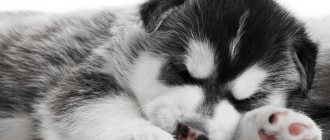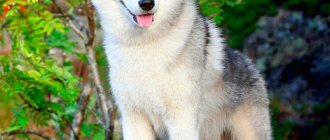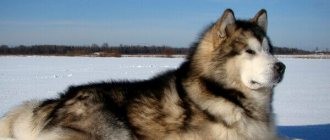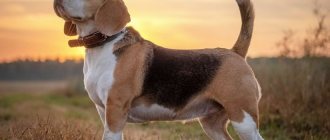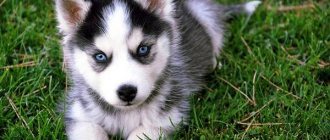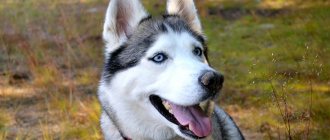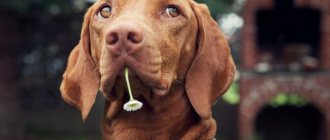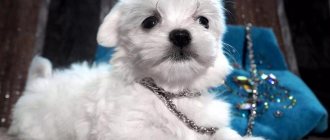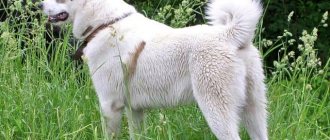Origin story
Husky is a collective name for a group of northern sledding breeds. Their purpose is to pull a team and transport small loads. These breeds are distinguished by their strength, endurance and ability to run fast.
The Chukchi are considered the “parents” of the husky. They crossed native species with wolves. The result was excellent working dogs capable of pulling sleds over vast distances. This made it possible to hunt large animals and expand the boundaries of their possessions. It was the Chukchi huskies that became the ancestors of the Siberian ones.
The Eskimos also appreciated wolf-like dogs and began to breed their own varieties. The name Husky comes from the abbreviation Eski: this is what Canadians called Eskimos. Northerners valued the breed not only for its fantastic endurance, but also for its unpretentiousness in food: they could be fed dry fish.
Sled dogs played an important role in the lives of their owners. They were full members of the tribe and were highly respected. According to some customs, huskies were invited into the house after the birth of a child and the dogs were allowed to warm the baby.
The Husky group includes:
- Siberian;
- Alaskan;
- Sakhalin;
- Japanese;
- Klee Kai (mini husky).
They have comparable performance data, but differ in appearance, character and habitat.
Alaskan Husky
This variety is a mixed breed group that includes crosses of aboriginal breeds, malamutes, Siberian huskies and even pointers. It is formed on the basis of performance characteristics. Currently, the group of Alaskan huskies includes all non-northern sled breeds (or northern ones, but not registered in the FCI). Huskies came to the peninsula along with traders. Alaskans do not have a traditional breed standard. Individuals up to 66 cm tall and weighing up to 27 kg take part in the races.
General description:
- The head is cone-shaped, the muzzle is rectangular, tapered towards the end.
- The jaws are strong, with a strong grip, scissor bite.
- The eyes are almond-shaped, medium in size. The iris is colored blue, yellowish or brown.
- The ears are erect, triangular, set high, with pointed tips.
- The body is strong, with pronounced muscles. The outlines are rectangular.
- The tail is high-set, curled into a ring, and abundantly covered with hair. Usually thrown on the back.
- The limbs are strong, straight and muscular. Very powerful, with strong bones.
- Paws are oval shaped.
The coat is less dense than that of the Siberian Husky. Guard hairs of different lengths. This helps distribute the heat during a long run. The undercoat is thick and abundant. The color can be of any shade.
Alaskans are distinguished by their gentle nature and do not show zoo aggression. They love spending time with their relatives and often try to attract the attention of an unfamiliar dog. They are also highly trainable and not prone to dominant behavior.
Alaskans are naturally jumpy, easily overcoming a 2-meter fence. The owner will have to surround the house with a high fence.
What to feed?
These dogs eat little, but after intense exercise they need to replenish lost energy. There are two feeding options - natural food and ready-made diets. Many owners prefer the second option. It saves time, but not money. Good food doesn't cost much. And cheap food below the “Premium” class is not suitable for Siberian Huskies.
There is no universal option that would suit all dogs. Feed selection is carried out individually. At first, the puppy is fed what he is accustomed to from the breeder. Gradually he is transferred to a different diet, monitoring the pet’s well-being.
In the case of ready-made dry food, follow the manufacturer's instructions. However, the daily portion will need to be adjusted. If you choose natural food, then they are supplemented with vitamin and mineral supplements.
Puppy diet
Up to 4 months, puppies are fed 4 times a day. When choosing natural feeding, you can choose the following menu:
- breakfast – cottage cheese, grated carrots with an apple (vegetables can be replaced with 2 eggs);
- lunch – raw meat or fish (about 200 g);
- afternoon snack – kefir (0.5 l);
- dinner – meat with porridge (ratio 1:3).
When the puppies reach 4 months, the afternoon snack is removed and the share of meat products is increased. At 7–8 months the pet is deprived of lunch. A dog's diet per year looks like this:
- breakfast (choice: cottage cheese, meat or fish);
- dinner (meat + porridge).
The amount of food is calculated individually. The dog must eat the entire portion. But if she begins to gain weight, and the ribs are already difficult to feel, then feel free to cut back on the amount of food.
Adult dog diet
Adult Siberian Huskies can be switched to single meals. Basic pet products:
- meat – 60–70%;
- vegetables and fruits – 20–30%;;
- porridge – no more than 20%.
The basis of the diet should be meat. Beef trimmings and tripe and boneless chicken are suitable for dogs. Among vegetables, preference is given to carrots, cabbage, and pumpkin. Huskies love apples, pears, and other fruits. They are not averse to preying on them right in the garden. As for cereals, they are not suitable for everyone.
Features of fat metabolism in Siberian Huskies
There are dogs with two types of fat metabolism:
- protein-carbohydrate – typical for European breeds;
- protein and fat – traditional for northern breeds.
In the first case, you can safely give porridge: buckwheat, rice, good quality oatmeal. But if your pet has retained its native protein-fat metabolism, then its body will not absorb cereals. The type of exchange can be determined experimentally.
If after a week of feeding porridge the dog begins to smell unpleasant, then it has a protein-fat metabolism. Cereals are not suitable for such a pet. What to feed the husky in this case? Mainly meat products with the addition of vegetables.
Siberian Husky
Siberian Huskies are indigenous dog breeds bred by the peoples of the Far North. This breed is genetically close to the wolf. During the Gold Rush it was imported to North America, where it became widespread due to its performance characteristics. Oddly enough, in their homeland, huskies were considered insufficiently promising and were excluded from breed registries. Dog breeding began in the USA, where the official standard was established.
Breed standard:
- Dimensions: height up to 60 cm, weight up to 27 kg.
- The head is medium in size, regular in shape, tapering from the back of the head to the eyes. The muzzle tapers slightly towards the nose. The nose is large, with well-cut nostrils. Its color depends on the type of color.
- The eyes are almond-shaped, medium in size. The iris is colored blue or brown.
- The jaws are powerful, well developed, with a scissor bite.
- The chest is of moderate breadth, set deep.
- The tail is sickle-shaped, similar to a fox. Should not be thrown on the back or hanging from the side.
- Limbs are straight and powerful.
- The body is strong, with well-developed muscles, and harmonious proportions.
The coat is straight and of medium length. The structure is not rough, soft. The coat is abundant and dense, effectively protecting against the cold. The undercoat is thick and well developed. May be absent during seasonal molts.
The color palette is very diverse. Siberians can be:
- white;
- gray-white;
- silvery white;
- red;
- chocolate;
- fawn;
- wolf color;
- sable;
- agouti;
- piebald;
- marble;
- splash coat;
- black-and-white;
- isabella;
- black.
There are about 20 types of colors in total.
Siberian Huskies have a friendly, affable disposition. They are not prone to aggression and cannot be guard dogs. This breed enjoys good health, but is prone to eye diseases, dermatitis and laryngeal paralysis.
Diseases and life expectancy
The breed is susceptible to various diseases at any age. The most common ones are:
- eye diseases;
- dermatitis;
- neurological diseases;
- high blood pressure;
- adenoma and malignant tumor of the testicles in males.
With proper care, the average life expectancy of a dog is 12-15 years.
Husky mini (Klee Kai)
Klee Kai is an original breed, bred in the USA in the 70-80s by Linda Spurlen and Eileen Gregory. The Klee Kai was probably the result of crossing Alaskan and Siberian Huskies. The creators of the breed have not yet “declassified” the data. Klee Kais are modest in size: the toy variety grows up to 33 cm, the standard Klee Kai - up to 42. Their weight ranges from 4 to 10 kg.
Mini-huskies are distinguished by a characteristic mask on their face and a tail curled into a donut. Overall, this is a miniature, well-built dog with a fluffy, thick coat. Klee Kais can be colored black and white, gray and white, and fawn.
They are known for their easy-going, playful nature and cat habits. Mini Huskies are great companions and get along well with animals. Due to the youth of the breed, they do not have genetic diseases, but 1 in 100 individuals suffer from blood diseases.
What group do Husky dogs belong to?
A. hunting B. hounds C. decorative D. sledding
To correctly answer the question about which group the husky dogs belong to, you should choose the last answer option from the four offered to choose from, that is, the option under the letter “D”. Huskies are sled dogs . Dogs of this breed have a very developed hunting instinct, but huskies are still considered unsuitable for hunting, since they only track prey, catch it, but do not bring it to the hunter, as a hunting dog should. For sled dogs, the Husky breed is simply ideal - they are fast and resilient, work well in a harness, are suitable for transporting goods, tolerate cold well, and can withstand long distances.
Husky dogs are a popular breed; you can often see them even in an ordinary city. These dogs are quite well tamed, obedient, but still, by and large, these are DRIVEN dogs, they need the road and movement. It’s a pity that owners often forget about this.
Husky is a sled dog, which is why I am always amazed why people get and keep this breed of dog in urban environments. After all, they are not able to give the dog the load that they need at the genetic level. Urban Huskies are doomed to an uncomfortable life. Lawmakers are concerned about the safety of people, they prohibit keeping aggressive fighting dogs, but for some reason they always forget about the dogs themselves. However, this is not the case in all countries. Husky is an artificial breed bred at the beginning of the last century solely for the purpose of being used as a sled dog. The basis is based on dogs from the northern regions of Siberia. Therefore, the correct name of the breed is Siberian Husky. The answer is HUSKY.
The cutest breeds of dogs that our mother, nature, created by her grace: just look at the eyes of these dogs alone. As for the question, here, of course, we choose the answer with the letter D - “DRIVEN”, huskies belong to this group of dogs.
Everyone is well aware of the breed of dog known as the husky, but not everyone knows that this breed was bred by American cynologists in the distant 30s of the twentieth century and this breed of dog was registered as a sled dog. So, the correct answer is under the letter D. mounts.
Another quiz question that participants can overcome with ease. Husky dogs are quite well known and of course they have nothing to do with hunting or even decorative dogs. Huskies are tireless workers, they belong to the group of Sled dogs, the last answer.
In some ways, these dogs, huskies, remind me of traditional huskies. This breed was obtained from the dogs of our northern peoples, Kerek, Chukchi and is considered the oldest breed. They were harnessed and ridden by the aborigines. So the answer here is D. rideables.
Husky dogs are very beautiful, especially with their eyes, and they can easily be classified as decorative. Nevertheless, the breed was bred as a sled dog, so Huskies are neither hunting dogs, nor hounds, nor even decorative dogs. Riding is the right option.
Nowadays it has become very fashionable to own Husky dogs, but people forget that these dogs belong to the sledding group. They keep them in multi-storey buildings in cramped apartments, where the husky feels constrained and uncomfortable. they need space and freedom.
Husky is a breed bred in the 30s of the 20th century, that is, not so long ago, but similar dogs in their, so to speak, original form have existed among the nomadic people of the north for a long time. They were usually used with training dogs as sled dogs. We choose the answer under the letter D - SLED dogs. Nowadays they are used much more widely.
Sakhalin Husky
Sakhalin Huskies are one of the oldest aboriginal breeds of the Nivkhs (a people living in the Amur region and Sakhalin). The historical name of the breed is Gilyak. They were used as sled and draft dogs. The breed was distinguished by its endurance and extreme unpretentiousness. During the winter season they were fed dried fish once a day. Currently, the Sakhalin people are almost extinct.
In appearance, they resemble a mix of Husky, Akita Inu and Spitz. In addition, Sakhalin residents are the largest representatives of the group. Males grow up to 70 cm and weigh up to 40 kg. The physique is distinguished by strong bones and well-developed muscles. The head is large, the muzzle tapers towards the nose. The ears are set high, triangular and fluffy. The coat is thick and abundant. The undercoat is dense and well developed. Pile length may vary. Available in all sorts of colors. The most common breeds are black, red, gray and brindle huskies. In the past, each color had its own cultural and religious meaning.
Sakhalin residents have a strong, fearless character, but need constant communication with their owner. Abandoned dogs become nervous and destructive. This species is prone to dominant behavior (especially males) and therefore requires firm and decisive leadership. Sakhalin residents do not know fatigue and can pull a team around the clock. These dogs require constant exercise.
Varieties of color
A short list of color options:
- Black. Absolutely black color is rare. There may be patches of white on the muzzle, chest, paws and tip of the tail.
- White. Rare snow-white color. The undercoat and coat are the same white color.
- Black and white. Approximately equal parts black and white wool. The undercoat is either completely black or snowy white. The upper part of the body is “filled” with black from the back of the head to the tail. The paws, chest, and belly are predominantly white.
- Grey. A common species with a gray coat and a silver, cream or beige undercoat.
- Silver. Cool color without interspersing warm tones. The undercoat is silver to snow-white, the coat is light gray to silver.
- Copper or chocolate. Rich chocolate tone with a copper tint.
- Ginger. The overall tone is lighter than chocolate. A pronounced red color, similar to a fox fur coat.
- Pale yellow. Warm pastel tone from light brown to fawn. The undercoat is also fawn or light cream. A reddish tint is unacceptable.
- Wolf grey. Warm gray tones interspersed with red, fawn or yellow. The undercoat is only beige.
- Sable. A very rare color with a bright copper undercoat. Each hair is beige-fawn at the root and dark gray or black at the end.
- Agouti. Shades from gray to deep black. Possible stripes. The undercoat may have a warm creamy tint. There are reddish areas on the paws. A distinctive feature is the black tip of the tail and a dirty dark “mask” on the muzzle.
In addition to the listed combinations, there are Isabella, saddle, black and tan, Splash Coat, piebald, harlequin and other color options.
Japanese Husky (Akita Inu)
Japanese Husky is the popular name for Akita Inu. They are one of the 14 oldest indigenous breeds. The Akita Inu's homeland is the Japanese island of Honshu. Traditionally used as watchdogs and hunting dogs. During the Second World War, the Akita was actively used as a service dog, so the owners began to cross it with a German shepherd in order to avoid being sent to the front (at that time, German shepherds were under state protection).
The Akita Inu is a Spitz-shaped dog that looks like a large husky. The Japanese grow up to 70 cm and weigh up to 40 kg. They are distinguished by a harmonious physique and long, dry limbs. The ears are triangular and set high. Almond-shaped eyes are set wide apart. The coat is thick and of varying lengths. The undercoat is abundant and soft. Color can be white, brindle and white-red.
These dogs are known for their calm nature and ability to be trained. A sharp mind allows them to make independent decisions. Akita Inu are prone to self-will and stubbornness. At the same time, they are brave, friendly and loyal dogs.
Key points in training
When training a Siberian Husky, it is important to take into account that the dog is not a working breed, so it is important to be patient when training. To raise an obedient dog, you need to start raising a puppy at 3 months. During training, it is necessary to show rigor and fairness.
During training, the puppy must be interested, because despite the sharp mind, if the dog is not interested, it will be difficult to achieve results. Commands must be given in a calm and confident voice. Husky breeders note that the dog follows commands faster not when ordered, but when asked.
Education should take place in a system of reward and punishment. The best punishment for a husky is to demonstrate strength and advantage. Punching as a method of education is unacceptable. Praise is an important element in learning. It can be supplemented with a piece of treat.
It is important to be patient during training.
Character
Huskies are sled dogs that have lived side by side with people for centuries. This made them capable of dialogue and real, sincere friendship. Northerners are friendly towards strangers and will not be able to act as a security guard.
Huskies have a special affection for children. They love outdoor games and are always ready to cuddle. These dogs make excellent nannies: they will never harm a child and will take care of his safety. Huskies are not prone to zoo aggression. They love to communicate with their relatives and get along well with cats, especially if they grow up together.
Sled breeds are distinguished by their intelligence and intelligence. The ancestors of modern breeds more than once had to make independent decisions during long transitions: survival depended on it. Their descendants have inherited a lively mind and often show stubbornness.
Husky is an active, cheerful breed. They love long walks with their owner and will happily support the game. Husky is suitable for sports owners who will take the animal for a run or bike ride.
In winter, huskies need to be harnessed to a sleigh. This is necessary for physical and psychological health. Northerners are made for work. While running in harness, they use all their abilities and resources, which helps maintain interest in life. Dogs locked in an apartment suffer from behavioral disorders and can die of boredom.
Useful information about huskies
Huskies often have blue eyes.
Finally, we will give some useful advice to future breeders and happy owners of such a wonderful dog as a husky.
Huskies are always for walks and activity.
If you love dogs and dream of having a real four-legged friend, then the Siberian Husky is the ideal choice. The main thing is to love and care for your pet. In this case, he will answer you with boundless devotion!
Care and maintenance
Huskies are not suitable for apartment living. They need constant movement and a high level of physical activity. A bored husky can wreak havoc in an apartment or become lethargic and apathetic.
It is recommended to keep Northerners in a house with a spacious yard and a high (more than 2 m) fence well sunk into the ground. Huskies love to dig up the yard and will easily overcome a 2-meter fence. This breed easily tolerates frost, which means it is suitable for keeping in an enclosure. The main thing is that the enclosure is equipped with a booth and a warm floor.
Huskies cannot be kept on a chain! This is a sled dog, not a guard breed. Northerners are independent and freedom-loving, they love to participate in family life. If they are chained, they turn into unstable, deeply unhappy dogs.
Husky fur does not require careful grooming: they are known for their cleanliness and take care of their fur on their own. It is enough to comb your pet weekly and bathe it 1-2 times a year using special shampoos.
Northerners molt in autumn and spring. In spring, the dog sheds its winter coat, which manifests itself in complete loss of the undercoat. During this time, the pet is combed daily using a furminator. It is recommended to do this outside, otherwise the whole house will be covered in fur.
Huskies spend a lot of time outdoors, so their nails wear down on their own. If this does not happen, they are cut every 2 weeks. The ears are examined regularly and wiped once a month with a cotton swab dipped in warm water, or a special lotion is used.
You should not clean your ears with cotton swabs: they can easily cause injury.
The eyes are cleared of secretions as needed. They are wiped with cotton pads soaked in warm water or chamomile infusion. Movements should be directed towards the corner of the eye.
A husky's ears stand up at 2 months of age. If this does not happen, they are brought to a standing position using special structures. Also, we must not forget about regular vaccinations and oral hygiene.
Vaccinations, susceptibility to diseases
This is a healthy breed. But it is also characterized by some specific diseases. The most common are:
- diseases of the endocrine system (diabetes mellitus, thyroid problems);
- eye diseases (corneal dystrophy, cataracts, glaucoma, retinal atrophy, entropion);
- diseases of the nervous system (epilepsy, degenerative myelopathy);
- skin diseases (depigmentation of the skin and nose, atopic dermatitis);
- diseases of the musculoskeletal system (joint dysplasia);
Specific diseases of Siberian Huskies include juvenile laryngeal paralysis, eusinophilic granuloma of the mouth, and spastic colitis. All these diseases will bypass your pet if he does not have problems with genetics and you take care of him properly.
Treatment against worms and ticks
Huskies have a passion for travel and adventure. They actively look for them in the most unusual places for people. They like to get food from garbage dumps. During such adventures, pets can easily pick up helminths. Deworming is done once every three months.
In the spring and summer, you need to regularly treat your dog for ticks. Drops and sprays are suitable. Anti-tick drops are selected based on the weight of the pet. The products are used according to the instructions. As a rule, treatment is carried out once every 28 days. After this, a parasite collar is put on. Before a walk in the forest, you can apply a little “human” tick repellent to your fur.
Vaccinations, vaccination schedule
Two weeks before the vaccine is administered, deworming is carried out.
- At 8–9 weeks of age, the polyvalent DHPPi vaccine is given against distemper, hepatitis, parvovirus, parainfluenza and the Lepto vaccine against leptospirosis.
- A booster shot (DHPPi) is given after 14–28 days. Usually the puppy is just 2.5–3 months old. The vaccine used is DHPPi + (RL) rabies and leptospirosis.
- Then every year they are vaccinated against canine distemper, hepatitis, parvovirus (DHP) + (RL), rabies, and leptospirosis.
Training and education
Huskies are pack dogs. They have a sense of collectivism. The strongest individual in the team becomes the leader. If one of its members is out of step with the general rhythm, the pack punishes the lagging behind. This means that the owner must have absolute authority. If you show weakness even once, the dog will sit on your neck. She will begin to impose her own routine on the family and dominate the owner.
Raising a puppy should be done from the first months of life. After the baby moves to a new home, the rules of behavior are explained to him, he is taught the toilet and diet. To toilet train a puppy you need to do the following:
- Cover the puppy's space with disposable diapers and gradually reduce their number. If the owner notices that the puppy is about to make a puddle in the wrong place, he should take the baby and transfer it to the diaper.
- To train a puppy to use the toilet outside, you need to take him out into the yard after eating, waking up and playing actively. It is important not to return home until the dog is done with everything.
- If the puppy does not get used to the toilet outside for a long time, you can take the soiled diaper out into the yard a couple of times so that he establishes a connection.
Dog training should be regular. Under no circumstances should you physically punish huskies: they do not respond to this method of suggestion. As punishment, it is enough to press its head to the floor or ground (this is what the leaders of the pack do) so that the dog comes to terms with the superiority of the owner.
Huskies require professional training. Mistakes in parenting can have unpleasant consequences in the future.
Learning ability
The initial training of a husky consists of the puppy learning its name and approaching the owner's call. Once your pet has mastered the exercises, introduce more challenging elements.
Huskies are stubborn and difficult to train.
The nuances of properly raising a dog at home on the site:
- In the house, define areas where the puppy is allowed to be and fence them off with drywall.
- Teach your puppy to use a diaper or litter box. After feeding, take him to a place to relieve himself and hold him there for a couple of minutes. If the puppy goes to the toilet, praise it.
- Be consistent in training - having given a command, force the dog to carry it out with the help of treats or mechanical influence.
- Do not punish your child for wrong actions - instead, develop him and methodically practice commands.
Don't allow yourself to shout at your dog - loud noises will make him go into a stupor.
Siberian Husky: photo, description of the breed, character, reviews
Mixture and comparison
Sled breeds were formed under comparable conditions, which is why there are dogs similar to huskies in color and appearance.
Huskies and huskies
They differ in their scope of use. Huskies are draft breeds bred in the North. Laikas are designed for hunting. Huskies are ready to work around the clock, huskies run out of steam much faster. Huskies are silent, reserved dogs. They express emotions by purring and howling. Laikas are big fans of making noise. Huskies have a powerful constitution, blue eyes and a bushy, fox-like tail. Laikas have an elegant structure, and their tail is curled into a donut shape.
Husky and malamute
Malamutes are designed to carry heavy loads at low speeds. Huskies are used to carry light loads over long distances. They develop high speed. The Malamute is larger and more massive than the Husky. Its average height is 60 cm. It is distinguished by its fluffy coat. The husky's pile fits well to the body.
For a malamute, blue eyes are a breed deviation, for a husky it is the preferred color. The husky has a crescent-shaped tail, while the malamute has a more furry tail. He moves like a fan. Huskies are not characterized by aggressiveness; it is easy to find a common language with them. Malamutes are strong, independent dogs that strive to dominate their owner. They quickly get bored with standard training. The owner must be able to keep the Malamute occupied, otherwise he will come up with entertainment himself.
Northerners are not only tireless workers, but also handsome. This inspires breeders to create unexpected crossbreeds. These include:
- A cross between a husky and a spitz. This mixed breed is called a Pomsky. He is a miniature Spitz-shaped dog with a characteristic husky color. Adults weigh from 3 to 14 kg, the size of the Pomsky is unpredictable. They have a friendly, playful nature and get along well with children.
- A cross between a shepherd and a husky. This beautiful mixed breed looks like a shepherd with blue eyes. Activity and friendly character are the heritage of the husky. Their appearance depends on the predominance of one or another blood. This crossbreed loves to imitate loud noises, including alarms and sirens. Also, these mestizos tend to run away from their owners, so they should not be lost sight of.
- A cross between a Husky and a Labrador. This hybrid looks like a Labrador with blue eyes. Cases of heterochromia are common. The character is dominated by the traits of a Labrador, but in a stressful situation the firmness inherent in a husky appears.
- Another common mixed breed is Akita Inu and Husky. He is a husky with the characteristic Akita coloring.
Mixed breeds are no worse than purebred dogs, but often suffer from genetic disorders. Therefore, when getting such a pet, you need to be prepared for unpleasant consequences.
Walking and exercise
Understanding what makes a dog do certain things will help raise a pleasant pet. Walking is not only physical activity, but also an element of education. Dogs of this breed have a highly developed sense of pack hierarchy. This helped their ancestors survive in difficult conditions. This trait must be respected.
While walking you need to follow these rules:
- do not let an untrained dog off the leash;
- do not leave the dog unattended in an unfenced area;
- walk young animals on a long leash.
Choosing an activity for your husky while walking
This is a sled dog. All activities similar to this type of activity will be to the liking of the pet. A good choice for four-legged fidgets:
- dog sledding;
- skijoring;
- weightpulling (cargo movement);
- hiking;
- cycling and roller skating;
- agility.
Walking mode
Full physical maturity in this breed occurs at three years of age. However, even puppies can run in a harness. Up to a year, the puppy’s joints are still developing, so they need to be loaded wisely. If you plan to use your dog in racing, you need to train him from an early age. In other cases, you should simply provide your dog with an activity that he enjoys.
The puppy is taught to walk from the age of 8 weeks. In a day, a toddler can cover up to 1.5 km, only in two passes. The intensity of the loads is gradually increased. Starting from 9 months, a young dog can already run in a harness. But heavy loads are still too much for him to handle. He will be able to work with them no earlier than 18 months of age.
How to choose a puppy
The best place to buy a puppy is a specialized nursery. The pedigree guarantees not only the purity of the blood, but also the absence of deviations. Puppies raised in kennels have social skills and are toilet trained. In addition, responsible breeders provide recommendations on feeding and maintenance. Inexperienced owners can always seek advice. To make an informed decision, you need to visit several exhibitions, read reviews on the Internet and look at babies from different litters.
At the screenings, pay attention to the following:
- organization of living space;
- nutrition;
- mother's health and appearance;
- condition of the puppy’s coat, skin, teeth, eyes and joints;
- absence/presence of discharge from the nose and eyes;
- communication between puppies;
- reaction to strangers;
- activity (puppies should not be lethargic or hyperactive: both conditions are abnormal);
- declared set of documents and pedigree.
It is recommended to take an experienced owner or specialist to the viewing: they will help take into account all the nuances.
Where to buy and price
Siberian and Alaskan huskies are common breeds in Russia, so buying a purebred baby will not be difficult. Akita Inu is considered more rare, but in cities with a population of over a million there will definitely be a nursery. Sakhalin Huskies are on the verge of extinction, so it is almost impossible to purchase such a puppy. Klee Kai is also a rare breed: less than a dozen kennels are registered in Russia and the price of a puppy can reach up to 350,000 rubles.
Siberian Husky kennels:
- Khaskvisher (Moscow and Vladimir region);
- Vento Libero (Moscow);
- Free Flock (Moscow).
Average cost: 25,000-50,000 rubles.
Aliski Husky Kennel:
- Silver of the North (Samara region).
The breed is not officially recognized, so the cost of puppies depends on the seller’s price tag.
Akita Inu kennels:
- Indigo Smile (St. Petersburg);
- Mai Hoshi (Moscow);
- Milana Light (Penza).
Average cost: 40,000-70,000 rubles.
Nicknames for a husky boy: Alex, Altai, Thunder, Max, Wolf, Odin, Dingo, Zorro, Zeus, Cosmos, Lazar, Fox. Names for husky girls: Aurora, Alma, Bella, Gerda, Runa, Fairy Tale, Umka, Freya, Tessa, Eva, Elsa.
Tips for choosing a husky puppy
When choosing, it is advisable to take the competent advice of an experienced dog handler or have your own experience in dog breeding. You should choose an active puppy, with moderate fatness and characteristics characteristic of the breed. It should be borne in mind that as they grow older, the color of the chosen four-legged friend may change.
In order not to inadvertently buy a mestizo, you definitely need to pay attention to the appearance:
- from an early age, the tail in a calm state should be lowered and have no curls;
- the husky's tail is located below the level of the top line of the back;
- puppies have strong and tightly built bones;
- the ears are dense, set close to each other, erect;
- the tips of the ears are slightly pointed, with a wide base near the skull.
The husky's character does not manifest itself in aggression or mistrust even at an early age. Dogs of a young age show a keen interest in a stranger who may become their owner, demonstrating in every possible way their curiosity and willingness to enjoy a treat.
When choosing, it is important not to be misled by the size of the dog. There are three varieties of the Husky breed: working, show and sporting type, which differ in height at the withers, massiveness of the bones and chest, and muscularity of the limbs. Therefore, attention must be paid to young animals, taking into account their further use - in competitions or at exhibitions. Working races with dogs are now practiced extremely rarely and only in the northern regions, so this criterion is not particularly relevant.
To avoid buying a mixed breed pet, it is important to review the documents for the bitch and male from which the litter was obtained. Such confirmation of the purebred of the breed is the dog’s passport, a document on the pedigree. In addition, both parents must have veterinary passports, which indicate the regularity of basic vaccinations and additional sanitary treatments.
The selected pet must have a metric, which is subsequently exchanged for the husky pedigree in the kennel club.
It is better to buy a husky that has reached the age of 6-8 weeks, not earlier. During this period, the stage of weaning from mother's milk has already passed and dogs from the entire litter are transferred to independent feeding. This will eliminate the risk of diseases of the digestive system, intoxication and defecation disorders due to a sudden change in diet.
Even before the decision is made to go for a new husky pet, you should familiarize yourself with the documents of the nursery or breeder, learn from reviews or their portfolio about the real results of breeding offspring: whether there are participants and prize-winners of exhibitions among the pets. It is also advisable to first familiarize yourself with the conditions of keeping husky dogs from the breeder and study photos of Siberian huskies - a female and a male, from which the offspring were produced.
Pros and cons of the breed
| + | – |
| Ideal working and sled dog | The rarity of some breeds and their high cost |
| A wonderful companion | Not suitable for apartment living |
| With proper upbringing, he gets along with cats. | Heavy seasonal shedding |
| Good with children | Requires professional training |
| Does not require careful care | May be stubborn and self-willed |
| Easily trainable | Requires a high level of physical activity |
| Suitable for active owners |
Huskies are hardy, freedom-loving dogs. They cannot be locked in an apartment and walked twice a day. Northerners need constant activity and will wither away from boredom and idleness. Huskies need a decisive, strong owner who will become his absolute authority. Keeping this breed is a big responsibility. The northerners will spin out of control as soon as they feel the weakness.
